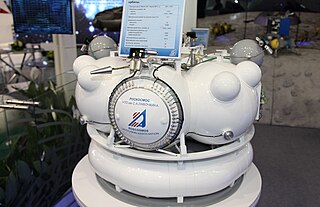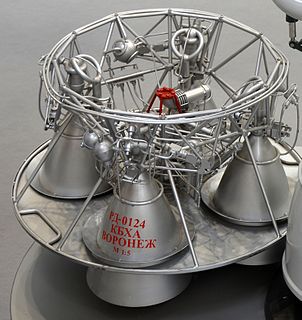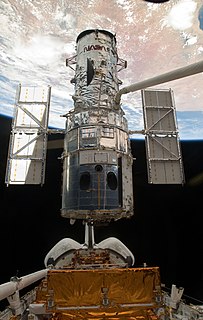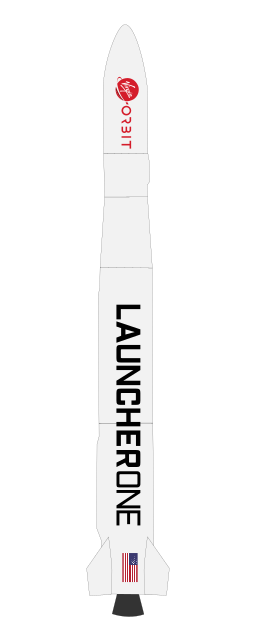| Mission type | Communication |
|---|---|
| Operator | VKO |
| Mission duration | Failed to orbit |
| Spacecraft properties | |
| Manufacturer | ISS Reshetnev |
| Start of mission | |
| Launch date | 23 December 2011, 12:08 UTC |
| Rocket | Soyuz-2.1b/Fregat |
| Launch site | Plesetsk 43/4 |
| Orbital parameters | |
| Reference system | Geocentric |
| Regime | Molniya |
| Perigee | 900 kilometres (560 mi) |
| Apogee | 39,000 kilometres (24,000 mi) |
| Inclination | 65 degrees |
| Epoch | Planned |
Meridian 5 (Russian :Меридиан-5), also known as Meridian No.15L, was a communications satellite launched by the Russian Federal Space Agency which was lost in a launch failure in December 2011. The fifth Meridian spacecraft to be launched, Meridian 5 was to have been deployed into a Molniya orbit with an apogee of 39,000 kilometres (24,000 mi), a perigee of 900 kilometres (560 mi) and 65 degrees of orbital inclination; [1] from which it would have provided communications for the Russian military. It would have been operated by the newly formed Russian Aerospace Defence Forces.

Russian is an East Slavic language, which is official in the Russian Federation, Belarus, Kazakhstan and Kyrgyzstan, as well as being widely used throughout Eastern Europe, the Baltic states, the Caucasus and Central Asia. It was the de facto language of the Soviet Union until its dissolution on 25 December 1991. Although nearly three decades have passed since the breakup of the Soviet Union, Russian is used in official capacity or in public life in all the post-Soviet nation-states, as well as in Israel and Mongolia.

A communications satellite is an artificial satellite that relays and amplifies radio telecommunications signals via a transponder; it creates a communication channel between a source transmitter and a receiver at different locations on Earth. Communications satellites are used for television, telephone, radio, internet, and military applications. There are 2,134 communications satellites in Earth’s orbit, used by both private and government organizations. Many are in geostationary orbit 22,200 miles (35,700 km) above the equator, so that the satellite appears stationary at the same point in the sky, so the satellite dish antennas of ground stations can be aimed permanently at that spot and do not have to move to track it.
Meridian (satellite) is a Russian Communication satellite system, consisting of several satellites:
Meridian 5 was launched on a Soyuz-2.1b rocket with a Fregat upper stage, from Site 43/4 at the Plesetsk Cosmodrome. [2] The launch took place at 12:08 UTC on 23 December 2011, with the rocket performing nominally during first and second stage flight. At 288 seconds after launch, the Blok I third stage's RD-0124 engine ignited to begin its burn. [2] During third stage flight, an anomaly occurred which prevented the rocket from reaching orbit.

Fregat (Russian: Фрегат, frigate) is an upper stage developed by NPO Lavochkin in the 1990s, which is used in some Soyuz and Zenit rockets. Its liquid propellant engine uses UDMH and N2O4.

Site 43, also known as SK-3 and SK-4, is a launch complex at the Plesetsk Cosmodrome in Russia. It consists of a two pads, Sites 43/3 and 43/4, and has been used by R-7 derived rockets since the early 1960s.

The RD-0124 is a rocket engine burning liquid oxygen and kerosene in a staged combustion cycle. RD-0124 engines are used on the Soyuz-2.1b and Soyuz-2-1v. A slight variation of the engine, the RD-0124A, is used on the Angara rocket family URM-2 upper stage. RD-0124 is developed by Chemical Automatics Design Bureau.
An official spokesman stated that the launch had been terminated 421 seconds into flight, by means of the rocket's thrust termination system. Telemetry recorded by NPO Lavochkin, however, indicated that the rocket had veered off course 425 seconds after launch, with data suggesting that there had been an explosion. Another report indicated that the engine had lost thrust 427 seconds after launch. [2] It was the first orbital launch to be conducted by the Aerospace Defence Forces, which had been formed at the beginning of the month. [3]
Debris from the launch fell over the Novosibirsk Oblast in Siberia, near Ordynsk. One piece of debris fell through the roof of a house in Cosmonaut Street in the village of Vagaitsevo. [4] Despite debris falling in residential areas, [5] no injuries were reported. [4]

Novosibirsk Oblast is a federal subject of Russia located in southwestern Siberia. Its administrative and economic center is the city of Novosibirsk. The population was 2,788,849 as of the 2018 Census.

Siberia is an extensive geographical region spanning much of Eurasia and North Asia. Siberia has historically been a part of modern Russia since the 17th century.










